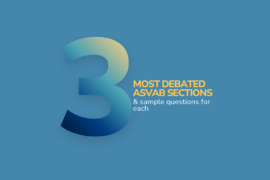So, you’ve decided to join the Army and are wondering how to best prepare for stellar Army ASVAB and AFOQT Scores! Standardized tests, like the ASVAB and AFOQT, help determine which job will be a good fit for you and your skillset, so it’s essential to know what to aim for with your scores. In this article, we will discuss the specific Army ASVAB and AFOQT score requirements for joining the Army as well as the difference between the two tests.
Key Differences Between ASVAB and AFOQT
The purpose of the ASVAB test and AFOQT test differ slightly. ASVAB is primarily for enlisted roles and AFOQT is primarily for Officer and aviation roles. Whichever test you are taking, it’s important to understand how Army ASVAB and AFOQT scores work.
Overview of the ASVAB
The ASVAB (Armed Services Vocational Aptitude Battery) is a multiple-aptitude battery consisting of either nine or ten subject tests. More than 1 million people take it to join the military or as part of a student testing program offered in high schools each year. Its primary purpose is to determine your basic skills and your aptitude. The scores determine Military Occupation Specialties (MOS), your specialized job. ASVAB can also be taken by those already in the military to change career fields when qualifying ASVAB scores are not on file for the career switch.
ASVAB Subject Tests
Four ASVAB subject tests count toward your AFQT score, the score that determines eligibility for enlistment. The composite of the ASVAB subject tests is formed from the following:
- Word Knowledge
- Paragraph Comprehension
- Arithmetic Reasoning
- Mathematics Knowledge
The actual scores you get on your subject tests are considered raw scores. The military uses raw scores to compute scoring for specific purposes, such as the AFQT. The AFQT raw score is then converted into a percentile score. If you have a General Education Development (GED) test or do not have a high school diploma and take the ASVAB for enlistment, the military may require a higher AFQT score. Check with your recruiter for more details about requirements for the army. The minimum AFQT score for the Army is typically 31 for high school graduates and a 50 for GED holders,
ASVAB Sections
- General Sciences
- Arithmetic Reasoning
- Word Knowledge
- Paragraph Comprehension
- Mathematics Knowledge
- Electronics Information
- Auto and Shop Information
- Mechanical Comprehension
- Assembling Objects
- Verbal Expression
For a full overview of the ASVAB test content and practice tests, study with Peterson’s ASVAB prep.
Percentile Scores
ASVAB scores are reported as percentile scores, which indicate your standing about a national sample of students. Since test results are not exact measures of ability, ASVAB percentile scores are reported within a score band. The score band indicates the range within which your true score probably lies. The ASVAB score report indicates score bands with dashes surrounded by brackets. When bands for two tests overlap substantially, such as the Paragraph Comprehension and Arithmetic Reasoning tests, it is unlikely that the student has scored better on one than on the other. Where there is little or no overlap, it can be said with more confidence that the student’s ability ranking is higher in one area than the other.
Both same-grade/same-sex and same-grade/opposite-sex percentile scores are reported. The most important scores are those for the student’s same grade level and sex. These scores allow you to see your performance compared to that of your peers. The same grade/opposite sex percentiles are reported since men and women tend to perform differently on some ASVAB tests.
On those tests that make up the academic composites, the differences are slight. On the more technical tests, the differences are more significant. Men tend to perform better on the Electronics Information test, for example, and women on the Coding Speed subtest. The goal of reporting these differences is for students to determine if they need to gain additional experience through coursework or independent study to compete effectively and achieve their career goals.
Composite Scores
The composite scores you receive are combinations of results of two or more parts of the ASVAB.
ASVAB CODES
Your score report includes two ASVAB Codes, a primary ASVAB Code and a secondary ASVAB Code. ASVAB Codes are based on a five-level reduction of the Academic Ability Composite. The first number in the ASVAB Code spot is your primary code. It can be used to find the occupations most suited to your aptitude levels. The second number is your secondary code, and it can be used to locate the occupations next most suited to your aptitude levels. Using two ASVAB Codes greatly expands the list of possible occupations to be explored. The codes summarize your level of general ability, and, together with interest inventory results and personal preferences, they can be used to evaluate different occupations as possible career choices.
Specific MOC Occupation Scores
For specific MOC occupations, certain Army ASVAB scores may be necessary, and there may be an emphasis on certain subject areas. See the list below as an example:
- Clerical—high scores in Verbal Expression, Arithmetic Reasoning, and Mathematics Knowledge subjects are required
- Combat—high scores in Verbal Expression, Auto and Shop Information, and Mechanical Comprehension subjects are required
- Electronics—high scores in General Sciences, Arithmetic Reasoning, and Mathematics Knowledge are required
See a full list of MOC occupations, including Field Artillery, General Maintenance, General Technical, Mechanical Maintenance, Operators & Food, Surveillance & Communication, and Skilled Technical subject area emphasis here. You can find some of the specific scores needed for each job here by scrolling down to “Testing & Certifications” to see ASVAB score requirements, or by speaking with your recruiter about ASVAB scores for Army jobs.
AFOQT
The AFOQT ( Air Force Officer Qualifying Test) is primarily used for officer candidates in the Air Force. It is relevant for those considering Army aviation roles. AFOQT scores are used to select applicants for Air Force ROTC, Officer Training School (OTS), and other programs.
AFOQT Sections
- Verbal Analogies
- Arithmetic reasoning
- Word knowledge
- Math knowledge
- Reading comprehension
- Situational Judgement
- Self-Description Inventory
- Physical Science
- Table Reading
- Instrument Comprehension
- Block Counting
- Aviation Information
For a full overview of the AFOQT test content and practice tests, start studying today with Peterson’s AFOQT test prep.
AFOQT Minimum Scores for Army Aviation
The AFOQT pilot score assesses foundational skills and abilities that are necessary to complete pilot training. The composite includes Math Knowledge, Table Reading, Instrument Comprehension, and Aviation Information. For candidates looking to enter pilot training, the minimum passing score for this composite is 25. Always check with your recruiter to verify the AFOQT results needed for the role you are hoping for.
Army ASVAB and AFOQT Score Wrap-Up
After you receive your Army ASVAB and AFOQT scores, you’ll have a better idea of which job opportunities you can pursue. Your Army ASVAB and AFOQT scores help indicate the job areas you’d excel in after you join as an enlisted soldier—you may even discover new career paths you hadn’t considered. If you have an idea of the areas you’d like to serve, it’s’ important to study to meet the score requirements for that job field. Your ASVAB scores are the gateway to unlocking career opportunities in the Army, so focus on preparation, persistance, and take advantage of resources like Peterson’s Test Prep to ensure you’re ready for the next steps in your enlistment journey.



